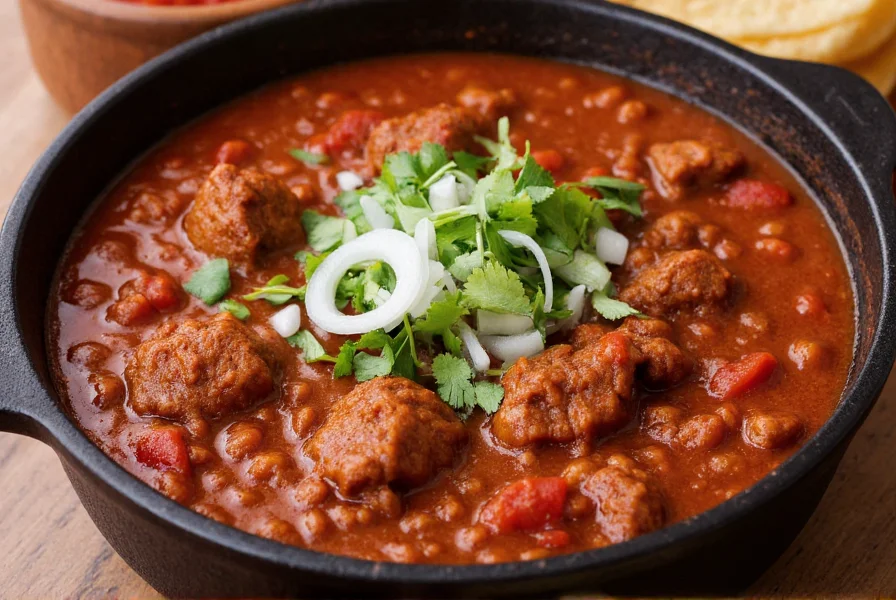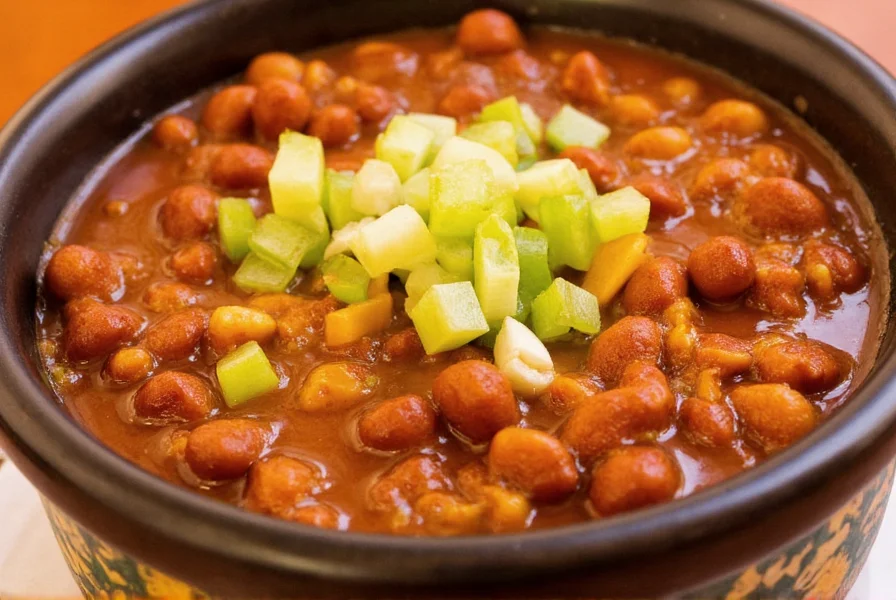When you crave a robust, flavorful chili that stands apart from typical Tex-Mex varieties, Colorado-style chili delivers a distinctive experience. Unlike bean-heavy versions, this regional specialty focuses on the deep, complex flavor of dried red chiles simmered with quality beef. Originating from the Southwestern United States, particularly Colorado and Northern New Mexico, this dish represents a culinary tradition that values simplicity and depth of flavor.
The History Behind Colorado-Style Chili
Chili Colorado traces its roots to the cattle ranching communities of the American Southwest. Spanish settlers introduced dried chiles to the region, while Mexican culinary traditions influenced the preparation methods. Unlike Texas chili, which often features a spicier blend of chiles and sometimes includes cumin, Colorado-style chili emphasizes the pure flavor of New Mexico or Colorado chiles with minimal additional spices. This regional variation developed as ranchers needed hearty, shelf-stable meals that could be prepared with ingredients available on the frontier.
What Makes Chili Colorado Unique
The defining characteristic of authentic chili Colorado is its sauce base made exclusively from rehydrated dried red chiles. Unlike other chili varieties that might use tomato products or beans as primary ingredients, traditional Colorado chili relies on the natural flavor of the chiles themselves. The absence of beans creates a smoother, more concentrated sauce that showcases the nuanced flavor profile of the chiles. While some modern variations include spices like cumin or garlic, purists maintain that only chiles, beef, and salt should form the foundation of this dish.
| Chile Type | Heat Level (Scoville) | Flavor Profile | Best For Chili Colorado |
|---|---|---|---|
| New Mexico Chile | 500-7,000 | Earthy, slightly sweet, moderate heat | Traditional choice, balanced flavor |
| Colorado Chile | 500-8,000 | Rich, deep red color, milder heat | Authentic regional option |
| Guajillo Chile | 2,500-5,000 | Fruity, tangy, berry-like notes | Excellent flavor complexity |
| Chiles de Árbol | 15,000-30,000 | Sharp, nutty, intense heat | Use sparingly for heat boost |
Essential Ingredients for Authentic Flavor
The magic of chili Colorado happens through careful selection of ingredients. For the most authentic results, source high-quality dried chiles rather than relying on pre-made chili powders. Look for pliable, deep red chiles without excessive brittleness. The beef selection matters significantly—choose well-marbled chuck roast for optimal tenderness after slow cooking. While traditional recipes contain no beans, some contemporary home cooks add a small amount of pinto beans for texture variation, though this deviates from the authentic preparation.
Step-by-Step Authentic Chili Colorado Recipe
Making authentic chili Colorado requires patience but delivers exceptional results. Begin by carefully removing stems and seeds from 8-10 dried New Mexico or Colorado chiles. Toast them gently in a dry skillet for 30-60 seconds per side until fragrant but not burnt. Transfer to a bowl and cover with boiling water, weighting them down to ensure complete submersion. Let soak for 20-30 minutes until soft.
While chiles soak, cut 2 pounds of beef chuck into 1-inch cubes. In a large Dutch oven, heat 2 tablespoons of oil over medium-high heat and brown the beef in batches, avoiding overcrowding. Remove browned beef and set aside. In the same pot, sauté 1 diced onion until translucent.
Drain soaked chiles, reserving 2 cups of soaking liquid. Blend chiles with reserved liquid until completely smooth, passing through a fine-mesh sieve to remove any remaining skins or seeds. Return the strained chile puree to the pot with the onions, add the browned beef, 3 cloves minced garlic, and 1 teaspoon salt. Bring to a gentle simmer, cover, and cook for 2-3 hours until beef is fork-tender.
Perfecting Your Chili Colorado: Pro Tips
Achieving restaurant-quality chili Colorado at home requires attention to detail. The toasting step for dried chiles is crucial—it enhances flavor complexity but requires vigilance to prevent burning. When blending the soaked chiles, use short pulses to avoid overheating the mixture, which can create bitter flavors. For optimal texture, always strain your chile puree through a fine-mesh sieve to remove any remaining skins. If your chili becomes too thick during cooking, add small amounts of beef broth rather than water to maintain flavor intensity.
Many home cooks wonder about the ideal cooking time. While 2 hours produces good results, extending the cooking to 3 hours allows flavors to meld more completely and creates exceptionally tender beef. For best results, prepare chili Colorado one day ahead—the flavors deepen significantly when allowed to rest overnight in the refrigerator.
Serving Suggestions and Traditional Accompaniments
Authentic Colorado chili shines when served with simple accompaniments that complement rather than compete with its complex flavor. Offer warm cornbread or bolillos (Mexican rolls) for dipping. Traditional toppings include finely diced white onion, fresh cilantro, and a dollop of sour cream. Some Southwestern households serve it with a side of rice, though purists maintain that the chili should stand alone. For a complete meal experience, pair with a crisp green salad and a cold Mexican lager.
Adapting the Recipe for Modern Kitchens
While traditional preparation requires hands-on attention, modern appliances can streamline the process without sacrificing authenticity. In a pinch, you can use a high-quality New Mexico chili powder (about 1/3 cup) combined with 2 cups of beef broth, though this won't match the depth of flavor from whole dried chiles. For busy cooks, after preparing the chile puree and browning the beef, transfer everything to a slow cooker and cook on low for 6-8 hours. Instant Pot users can pressure cook for 45 minutes followed by a natural pressure release.
Storing and Reheating for Maximum Flavor
Chili Colorado freezes exceptionally well, making it ideal for meal prep. Cool completely before transferring to airtight containers, leaving 1 inch of headspace for expansion. Properly stored, it maintains quality for up to 3 months in the freezer. When reheating, do so gently over medium-low heat, adding small amounts of broth if needed to restore optimal consistency. Avoid boiling, which can cause the sauce to break or become bitter. The dish's flavor actually improves after 2-3 days of refrigeration as the flavors continue to meld.
Frequently Asked Questions
What's the difference between chili Colorado and regular chili?
Chili Colorado specifically uses rehydrated dried red chiles (typically New Mexico or Colorado varieties) as the primary flavoring agent without beans. Regular chili often includes tomato products, beans, and a wider variety of spices like cumin. The Colorado style emphasizes the pure chile flavor with minimal additional ingredients.
Can I make chili Colorado without a food processor?
Yes, though it requires more effort. After soaking the chiles, you can finely chop them by hand and then press the mixture through a fine-mesh sieve using the back of a spoon. This traditional method takes longer but produces excellent results. Alternatively, a blender works well for creating a smooth puree.
Why does my chili Colorado taste bitter?
Bitterness usually comes from over-toasting the dried chiles or burning them during preparation. When toasting chiles, keep the heat medium-low and watch carefully—they should become fragrant within 30-60 seconds. Also, ensure you remove all seeds and white membranes, which contain most of the bitterness. If your chili tastes bitter, adding a small amount of sugar or honey can help balance the flavor.
Is chili Colorado supposed to be thick or thin?
Authentic chili Colorado has a medium consistency—thicker than a soup but thinner than a stew. It should coat the back of a spoon but still flow easily. During cooking, the sauce will reduce and thicken, so start with slightly more liquid than you think you'll need. If it becomes too thick, add small amounts of beef broth to reach your preferred consistency.
Can I use fresh red chiles instead of dried for chili Colorado?
While fresh red chiles can work in a pinch, they won't provide the authentic flavor profile. Dried chiles develop complex sugars and compounds during the drying process that fresh chiles lack. If you must substitute, use roasted red bell peppers combined with a small amount of ancho chili powder, but understand this creates a different flavor profile than traditional chili Colorado.













 浙公网安备
33010002000092号
浙公网安备
33010002000092号 浙B2-20120091-4
浙B2-20120091-4